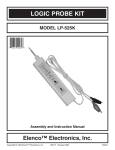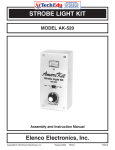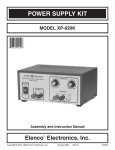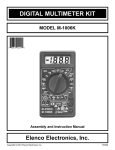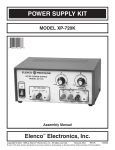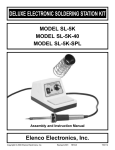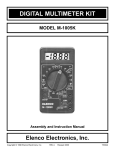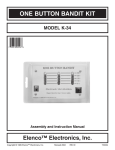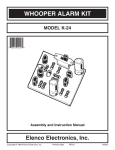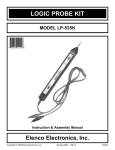Download Elenco Electronics ST-751 Specifications
Transcript
Schematic Diagram Signal Tracer Kit MODEL ST-751 Elenco Electronics, Inc. 150 W. Carpenter Avenue Wheeling, IL 60090 (847) 541-3800 http://www.elenco.com e-mail: [email protected] Assembly Instructions Elenco Electronics, Inc. Copyright © 1996 Elenco Electronics, Inc. Revised 2002 REV-D 752751 Parts List Specifications If you are a student, and any parts are missing or damaged, please see instructor or bookstore. If you purchased this signal tracer kit from a distributor, catalog, etc., please contact Elenco Electronics (address/phone/e-mail is at the back of this manual) for additional assistance, if needed. Injector: Impedance 100W Signal Level 75mV Harmonic Spacing 1kHz Pick Up: Input Impedance 100,000W Gain Adjustable 1 to 50 Resistors Qty. 1 1 1 1 1 1 1 3 1 2 1 1 1 Symbol Description R6 R16 R10 R13 R14 R8 R5 R3, R9, R15 R12 R1, R2 R4 R7 R11 100W 5% 1/4W (brown-black-brown-gold) 220W 5% 1/4W (red-red-brown-gold) 1kW 5% 1/4W (brown-black-red-gold) 2.7kW 5% 1/4W (red-violet-red-gold) 3.9kW 5% 1/4W (orange-white-red-gold) 4.7kW 5% 1/4W (yellow-violet-red-gold) 6.8kW 5% 1/4W (blue-gray-red-gold) 10kW 5% 1/4W (brown-black-orange-gold) 47kW 5% 1/4W (yellow-violet-orange-gold) 100kW 5% 1/4W (brown-black-yellow-gold) 180kW 5% 1/4W (brown-gray-yellow-gold) 220kW 5% 1/4W (red-red-yellow-gold) Trim Pot 220kW Part # Symbol Description C1 C2, C3, C7 C4,C5,C6,C9 .001mF Discap (102) .1mF Discap (104) 10mF Electrolytic (Lytic) Symbol Description D1 Q2 Q1 U1 D2 Diode 1N5234 Transistor 3904 Transistor MPS 5172 IC LM-358 LED Diode .125” 131000 132200 141000 142700 143900 144700 146800 151000 154700 161000 161800 162200 191622 Capacitors Qty. 1 3 4 Part # 231035 251010 271045 DC Input Voltage: 5 to 40 volts Input Current: 40mA max. Customer Service In the event that you encounter difficulty in getting the instrument to work properly, write or e-mail ([email protected]) us and explain: (1) the tests that you have made and (2) how the instrument behaved during these tests. Our experience has demonstrated that most difficulties can be corrected by an exchange of letters or a phone call. Semiconductors Qty. 1 1 1 1 1 Part # 315234 323904 325172 330358 350001 If the instrument continues to work improperly and you would like Elenco to locate the problem, send the unit along with a $10.00 check to our Service Department. They will repair, test the unit, and return it to you with a brief report of the problem. Miscellaneous Qty. 1 1 1 1 1 1 1 2 1 1 1 1 1 12” 36” 2” 48” Description Part # PC Board Switch Slide DPDT Probe Tip Knob (white) Earphone Jack Case Earphone 8W Screw #4 x 5/8” IC Socket 8-pin Alligator Clip Black Alligator Clip Red Alligator Clip Green Label Wire Cable 3-wire Tubing #20 PVC Solder 512751 541023 616001 622017 622102 623007 629350 643450 664008 680001 680002 680003 720510 815820 870801 890020 9ST4 -1- -10- Troubleshooting Guide Introduction The following guide should help in solving any problems encountered with your signal tracer. First, check your unit for soldering or wiring errors. Next, check the voltage at the emitter of transistor Q1. It should measure between 4.5 to 5.5 volts. If you still have a problem, refer to the following sections for help. Assembly of your signal tracer will prove to be an exciting project and give much satisfaction and personal achievement. If you have experience in soldering and wiring techniques, you should have no problems. For the beginner, care must be given to identifying the proper components and good soldering habits. Above all, take your time and follow the easy stepby-step instructions. Remember, an ounce of prevention is worth a pound of cure. Avoid making mistakes and no problems will occur. I. LED does not light: A) Be sure the red clip is connected to a positive voltage between 5 to 40 volts, and the black clip is connected to ground. Parts Verification B) Check the LED, it may be in backwards or open. Before beginning the assembly process, familiarize yourself with the components and this instruction book. Verify that all parts are present. This is best done by checking off each item against the parts list. C) If 4.5 to 5.5 volts is present at the emitter of transistor Q1, proceed to II. D) Check the zener diode D1, transistor Q1, and capacitors C5 and C6 for backwards installation. E) Make sure R9 and R10 are not interchanged. II. Weak or no sound in earphones with green clip connected to probe tip, and the LED is on: A) Check to see if the IC is in backwards. B) Must determine if the oscillator or amplifier is at fault. If an oscilloscope is available, look at the output of the op-amp (pin 1). There should be 3 to 5V of a 1kHz squarewave. If no scope is available, put the switch to tip receive position and remove the green alligator clip from the tip. Touch the tip with your finger. The earphone will buzz with 60Hz response when the gain control is fully clockwise and the amplifier is operational. C) If the oscillator is at fault: Check the LM-358 op-amp (pins 1, 2, 3, 4, and 8), resistors R1 to R6 and capacitors C1 and C2 for soldering or wiring errors. Replace the LM-358 op-amp if there are no solder or wiring errors. D) If the amplifier is at fault: Check the LM-358 (pins 4 to 8), trim pot R11, resistors R7, R8, and capacitors C3 and C4, for soldering or wiring errors. Replace the LM-358 op-amp if there are no solder or wiring errors. E) Check switch S1. -9- Resistors are identified by their color code as shown in the assembly instructions. Soldering The most important factor in assembling your signal tracer is good soldering techniques. Using the proper soldering iron is of prime importance. A small pencil type iron of 25-40 watts is recommended. The tip of the iron should be the flipplet point type and at all times kept clean and well tinned. Many areas on the main board are close together and care must be given not to form solder shorts. Size and care of the tip will eliminate problems. For a good soldering job, the areas being soldered must be heated sufficiently so that the solder flows freely. Apply the solder simultaneously to the component lead and the component pad on the PC board so that good solder flow will occur. Be sure that the lead extends through the solder smoothly, indicating a good solder joint. Use only rosin core solder of 60/40 alloy. Do not blob the solder over the lead because this could result in a cold solder joint. Assemble Components In all of the following assembly steps, the components must be installed on the top side of the board unless otherwise indicated. The top legend shows where each component goes. The leads pass through the corresponding holes and the board is turned to solder the component leads on the foil side. Solder immediately, unless the pad is adjacent to another hole, which will interfere with the placement of the other component. Clip excessive leads with diagonal cutters. Then, place a check mark in the box next to the step indicating that the step is complete. -2- Step-by-Step Assembly Instructions Theory of Operation Refer to Figure 1, install and solder the following resistors. The diagram on the back cover shows the schematic diagram of the signal tracer. Its main component is the dual op-amp LM-358. The first section serves as a squarewave oscillator. Positive feedback is through resistor R3. The frequency of oscillation is controlled by resistor R4 and capacitor C1. These components cause the op-amp to oscillate at a frequency of about 1000Hz. Resistors R1 and R2 are used to bias the input. Resistors R5 and R6 divide the signal to give an output of 75mV across the 100W impedance. The squarewave is rich in harmonics which extend into the AM and FM band of your radio. This allows signal tracing of AM, RF, and IF stages, and for testing of IF circuits in most FM radios. R1 R2 R3 R4 R5 R6 R7 R8 R9 R10 R12 R13 R14 R15 R16 R11 100kW 5% 1/4W 100kW 5% 1/4W 10kW 5% 1/4W 180kW 5% 1/4W 6.8kW 5% 1/4W 100W 5% 1/4W 220kW 5% 1/4W 4.7kW 5% 1/4W 10kW 5% 1/4W 1kW 5% 1/4W 47kW 5% 1/4W 2.7kW 5% 1/4W 3.9kW 5% 1/4W 10kW 5% 1/4W 220W 5% 1/4W Trim Pot 220kW brown-black-yellow-gold brown-black-yellow-gold brown-black-orange-gold brown-gray-yellow-gold blue-gray-red-gold brown-black-brown-gold red-red-yellow-gold yellow-violet-red-gold brown-black-orange-gold brown-black-red-gold yellow-violet-orange-gold red-violet-red-gold orange-white-red-gold brown-black-orange-gold red-red-brown-gold The second section of the op-amp is designed to be a variable amplifier. The input impedance of this amplifier is 100,000W. The gain of the amplifier is adjustable between 1 to 50 times, depending on the setting of trim pot R11. Resistors R7 and R8 bias the input circuit with C4 serving as a bypass capacitor, and C3, the input capacitor. The output of the amplifier is connected through capacitor C9, transistor Q2, and resistor R16 to the earphone jack. Trim Pot Transistor Q1 and the associated components are the voltage control circuit. Diode D1 is a 5.6V zener, allowing transistor Q1 to produce a constant 5V output. The circuit is capable of handling input voltages of between 5 to 40V. Switch S1 allows the choice of the probe tip to serve as the output of the oscillator signal, or as the pick up for the test signal. Figure 1 - Top Legend Install and solder D1, the 1N5234 diode. Note: the diode has polarity as indicated by the band. Mount the diode with the band corresponding to the PC board marking as shown in Figure 2. Band Notch Figure 2 Figure 3 Install and solder the 8-pin IC socket (U1). Carefully install the LM-385 IC (see Figure 3). Be sure that the notch is in the correct direction as shown in Figure 1. -3- -8- Testing the Signal Tracer Checking out your signal tracer is fairly easy. You will need a DC voltage source of between 5 to 40V. A 9V battery will do fine. Connect the red alligator clip lead to the positive voltage and the black lead to the negative voltage. The red LED should light up. Next, clip the green lead to the probe tip and connect the earphone to the jack. You should hear a tone in the earphone. Vary the gain control and the tone should vary in amplitude. Obtain an audio amplifier or an AM radio. Make sure the amplifier or radio is isolated from the power line. Set the probe slide switch into the tip inject position. Connect the green lead to the output of the amplifier or radio speaker. Touch the probe tip to the input of the last stage of the amplifier. The tone should be heard in the earphone or speaker of the radio. Continue injection by moving the tip toward the input and output of each stage. Vary the probe gain to prevent overload of the probe. If you have an AM radio, try injecting the signal into the IF and RF stages. The signal tracer produces a 1kHz harmonics which extend into the frequencies of the AM radio, and you will be able to hear these harmonics as 1kHz detected signals. At times, it may be advantageous to reverse the process. Move the switch to the tip receiver position. Now, connect the green lead to the input of the amplifier. The probe tip now is used to pickup the signal. Start with the first stage and continue to the last. This method is helpful if the last stage of the amplifier is defective. Should your signal tracer fail to perform as expected, refer to the troubleshooting guide for help in solving the problem. Refer to Figure 1 or the top legend on the PC board. Install and solder the following capacitors. C1 C2 C3 C4 C5 C6 C7 C9 .001mF (102) Discap .1mF (104) Discap .1mF (104) Discap 10mF Lytic (see Figure 10mF Lytic (see Figure 10mF Lytic (see Figure .1mF (104) Discap 10mF Lytic (see Figure 4) 4) 4) Figure 4 4) Install and solder the transistors with the flat side in the direction shown in Figure 1. Q1 - 5172 Flat Q2 - 2N3904 Install D2, the red LED. Cut two 7/16” plastic tubes to be used as standoffs. Place each LED lead into the tubing so that the LED stands 7/16” off of the PC board. Look for the flat side at the base of the LED. Mount it with the flat side as shown in Figure 1. Solder into place. Flat Tubes Mount the switch 1/8” off of the PC board, as shown in Figure 5. Install and solder the switch (S1) in the place shown in Figure 1. Install the probe tip. Cut a wire to 4 3/4”, strip 1/4” of insulation off of both ends. Solder one end to point P on the PC board. Solder the other end of the wire to the probe tip groove. One of two types of jacks is supplied in your kit. Look at the clip on the jack for identification and wire accordingly, as shown in Figure 5. Cut two wires to 1 3/4” and strip 1/4” of insulation off of both ends. Solder the wires to the lugs of the jack supplied as shown in Figure 5. Solder the other ends of the wires to the holes in the PC board marked “EAR” as shown in Figure 5. -7- Electrolytics have polarity. Place the negative (–) lead in the correct hole, as marked on the PC board and part. Mount the electrolytics so that they lay on their side. -4- Mount switch 1/8” off of the PC board. Clip 1/8” Clip Figure 5 Prepare the power cord. On one end, use diagonal cutters to strip off 4” of the gray casing to expose 3 wires (BE CAREFUL NOT TO CUT INTO THE 3 WIRES). Strip off 2” of gray casing off of the other end. Strip 1/4” insulation off of all 6 wires. Label Case Top Nut Jack Cable Notch Jack Notch PC Board Slide the alligator boots onto the 4” wires on the end of the power cord; red boot on the red wire, green boot on the green or white wire, and the black boot on the black wire. Then, solder the 3 clips to the wires. Slide the boots onto the clips. Bend tabs over the wire. Clip Screw Probe Notch Boot Screw Figure 6 On the other end of the cable, solder the black wire to the hole on the PC board marked “GND”. Solder the green or white wire to the hole marked “C”. Solder the red wire to the hole marked “B+”. Install the label onto the case. Be careful to place the label on neatly and correctly. Peel the backing off the expose the glue. Place the PC board assembly into the case as shown in Figure 6. Use two #4 screws to hold the case together. DO NOT OVER-TIGHTEN or the holes may strip out. Tighten the nut down on the earphone jack. Press the knob onto the gain control shaft. This completes the assembly. Your unit is now ready for testing. -5- -6-






